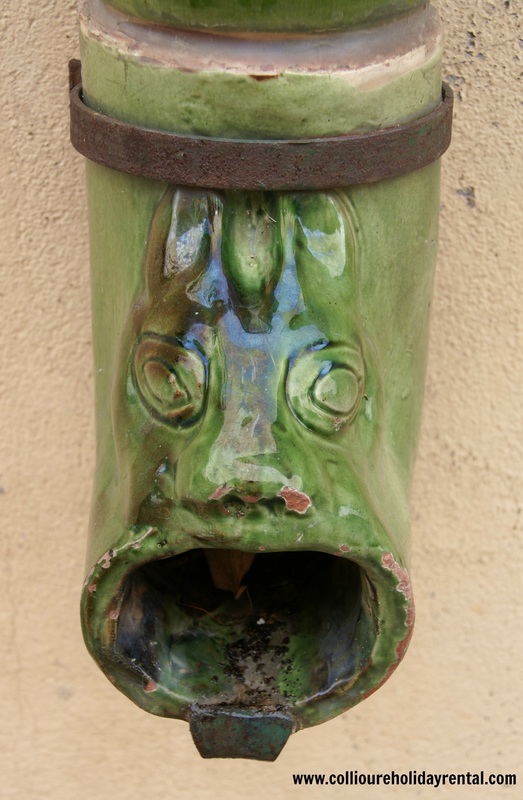
While strolling around the older neighbourhoods of Collioure, you will realize that several things make this town so charming: the proximity to the sea, the quaint cafes, the artist’s boutiques and the lovely streets lined with buildings painted in pretty pastel colours. There are also many unique things such as the ornamental wrought iron and if you look down, you will undoubtedly notice the unusually decorated drainpipes. The outlets of these simple, structural pipes on the front of buildings, have been fashioned as mythical open-mouthed creatures and are typically made of glazed ceramic. Most often they are painted in neutral colours of green or brown and were actually an integral part of the façade of most regional houses in the Pyrénées Orientales area.
This tradition of creating the faces is part of the local heritage. Catalan humour is such that they will strive to find fun in creating interesting pieces of art from the most mundane objects – even utilitarian things such as pipes meant purely for draining water! Now local artisans have continued this custom and create drainpipe ends that are glazed in many different colours.
Many people say these faces are a form of gargoyle – from the Latin word “gurguilio” that means throat. One of the definitions of gargoyle is:
“a spout, terminating in a grotesque representation of a human or animal figure with an open mouth, projecting from the gutter of a building for throwing rain water clear of a building.”
This has been a very common form of design that really has a true function. Many architects used multiple gargoyles on buildings to divide the flow of rain water from roofs and to help keep the building intact. Gargoyles were often used on cathedrals or churches and aside from their practical purpose, they were said to be a worthy method of warding off evil spirits. There are several very famous cathedrals sporting these interesting creatures. For example the Notre Dame Cathedral in Paris, Washington National Cathedral in Washington, D.C and the Sagrada Familia in Barcelona. Anyone who enjoys looking at older architecture will immediately notice many different styles of gargoyles and learning the meanings behind them are usually just as intriguing as their appearance. Click here to read an interesting article detailing the symbolism.
Next time you are walking the streets of Collioure, be sure to glance down and check out their “friendlier” version of the gargoyle. Now you will know exactly what they are and appreciate the subtle humour and wit of the Catalan people.
Related articles
This tradition of creating the faces is part of the local heritage. Catalan humour is such that they will strive to find fun in creating interesting pieces of art from the most mundane objects – even utilitarian things such as pipes meant purely for draining water! Now local artisans have continued this custom and create drainpipe ends that are glazed in many different colours.
Many people say these faces are a form of gargoyle – from the Latin word “gurguilio” that means throat. One of the definitions of gargoyle is:
“a spout, terminating in a grotesque representation of a human or animal figure with an open mouth, projecting from the gutter of a building for throwing rain water clear of a building.”
This has been a very common form of design that really has a true function. Many architects used multiple gargoyles on buildings to divide the flow of rain water from roofs and to help keep the building intact. Gargoyles were often used on cathedrals or churches and aside from their practical purpose, they were said to be a worthy method of warding off evil spirits. There are several very famous cathedrals sporting these interesting creatures. For example the Notre Dame Cathedral in Paris, Washington National Cathedral in Washington, D.C and the Sagrada Familia in Barcelona. Anyone who enjoys looking at older architecture will immediately notice many different styles of gargoyles and learning the meanings behind them are usually just as intriguing as their appearance. Click here to read an interesting article detailing the symbolism.
Next time you are walking the streets of Collioure, be sure to glance down and check out their “friendlier” version of the gargoyle. Now you will know exactly what they are and appreciate the subtle humour and wit of the Catalan people.
Related articles

 RSS Feed
RSS Feed